A Review on Graphene-Based Light Emitting Functional Devices
Abstract
1. Introduction
2. Graphene-Based Thermal Emitters
3. Plasmons-Assisted Emissions from Graphene
4. Electroluminescence (EL) Emissions
4.1. Electroluminescence (El) from Graphene
4.2. Electroluminescence (El) from GNRs
4.3. Electroluminescence (El) from FLG
5. Conclusions and Outlook
- The graphene-based active layer exhibits different optical, electrical, and chemical behavior. Oxidation of the graphene layer highly influences the efficiency, emission spectra, and lifetime of the graphene light-emitting device. The protective coating of the light-emitting graphene thin film possibly stops structural damage.
- By introducing an intersystem crossing path, singlet excitation could be achieved. The light source with an efficiency upper limit of up to 25% can be realized.
- Graphene-based doped material and nanocomposite material have not been investigated for light-emitting devices. As a possible solution, the doped graphene and graphene-based composite materials with numerous polymers could be used to tune the optical bandgap and surface plasmonic effect as well as thermal stability in graphene layer for optical emissions. Some critical issues in this emerging field of graphene-based light emitters, including short plasmons lifetime, instability of the induced bandgap, oxidation of the light active layer, low efficiency, and short lifetime, can also be overcome.
- Future demands for flexible optical and electronics require deformable and flexible light-emitting devices. Hence, future studies should be focused on the development of flexible graphene-based materials for optoelectronic devices.
Author Contributions
Funding
Acknowledgments
Conflicts of Interest
References
- Pareek, A.; Mohan, S.V. Graphene and its applications in microbial electrochemical technology. In Microbial Electrochemical Technology; Elsevier: London, UK, 2018; pp. 75–97. [Google Scholar]
- Yun, F.F.; Cortie, D.L.; Wang, X.L. Tuning the electronic structure in stanene/graphene bilayers using strain and gas adsorption. Phys. Chem. Chem. Phys. 2017, 19, 25574–25581. [Google Scholar] [CrossRef]
- Papageorgiou, D.G.; Kinloch, I.A.; Young, R.J. Mechanical properties of graphene and graphene-based nanocomposites. Prog. Mater. Sci. 2017, 90, 75–127. [Google Scholar] [CrossRef]
- Bao, W. Electrical and Mechanical Properties of Graphene. Ph.D. Thesis, University of California Riverside, Riverside, CA, USA, March 2012. [Google Scholar]
- Ramos Ferrer, P.; Mace, A.; Thomas, S.N.; Jeon, J.-W. Nanostructured porous graphene and its composites for energy storage applications. Nano Converg. 2017, 4, 29. [Google Scholar] [CrossRef] [PubMed]
- Alvarado, Y.E.A.; de la Cruz, M.T.R.; Hernández-Cocoletzi, H.; Cocoletzi, G.H. Graphene structures: From preparations to applications. Handb. Graphene 2019, 1, 323–357. [Google Scholar]
- Lee, H.C.; Liu, W.-W.; Chai, S.-P.; Mohamed, A.R.; Aziz, A.; Khe, C.-S.; Hidayah, N.M.S.; Hashim, U. Review of the synthesis, transfer, characterization and growth mechanisms of single and multilayer graphene. RSC Adv. 2017, 7, 15644–15693. [Google Scholar] [CrossRef]
- Alexeev, E.M.; Catanzaro, A.; Skrypka, O.V.; Nayak, P.K.; Ahn, S.; Pak, S.; Lee, J.; Sohn, J.I.; Novoselov, K.S.; Shin, H.S.; et al. Imaging of interlayer coupling in van der waals heterostructures using a bright-field optical microscope. Nano Lett. 2017, 17, 5342–5349. [Google Scholar] [CrossRef] [PubMed]
- Rosli, N.N.; Ibrahim, M.A.; Ahmad Ludin, N.; Mat Teridi, M.A.; Sopian, K. A review of graphene based transparent conducting films for use in solar photovoltaic applications. Renew. Sustain. Energy Rev. 2019, 99, 83–99. [Google Scholar] [CrossRef]
- Das, T.; Sharma, B.K.; Katiyar, A.K.; Ahn, J.H. Graphene-based flexible and wearable electronics. J. Semicond. 2018, 39, 011007. [Google Scholar] [CrossRef]
- Romagnoli, M.; Sorianello, V.; Midrio, M.; Koppens, F.H.L.; Huyghebaert, C.; Neumaier, D.; Galli, P.; Templ, W.; D’Errico, A.; Ferrari, A.C. Graphene-based integrated photonics for next-generation datacom and telecom. Nat. Rev. Mater. 2018, 3, 392–414. [Google Scholar] [CrossRef]
- Kusmartsev, F.V.; Wu, W.M.; Pierpoint, M.P.; Yung, K.C. Application of Graphene within Optoelectronic Devices and Transistors, In Applied Spectroscopy and the Science of Nanomaterials; Springer: Gateway East, Singapore, 2015; pp. 191–221. [Google Scholar]
- Sahu, S.; Rout, G.C. Band gap opening in graphene: A short theoretical study. Int. Nano Lett. 2017, 7, 81–89. [Google Scholar] [CrossRef]
- Junaid, M.; Witjaksono, G. Analysis of band gap in AA and Ab stacked bilayer graphene by Hamiltonian tight binding method. In Proceedings of the 2019 IEEE International Conference on Sensors and Nanotechnology, Penang Island, Malaysia, 24–25 July 2019; pp. 1–4. [Google Scholar]
- Witjaksono, G.; Junaid, M. Analysis of Tunable Energy Band Gap of Graphene Layer. In Proceedings of the 2018 IEEE 7th International Conference on Photonics (ICP), Langkawi, Malaysia, 9–11 April 2018. [Google Scholar]
- Koppens, F.H.L.; Chang, D.E.; García De Abajo, F.J. Graphene plasmonics: A platform for strong light-matter interactions. Nano Lett. 2011, 11, 3370–3377. [Google Scholar] [CrossRef]
- Cao, L.; Meziani, M.J.; Sahu, S.; Sun, Y.P. Photoluminescence properties of graphene versus other carbon nanomaterials. Acc. Chem. Res. 2013, 46, 171–182. [Google Scholar] [CrossRef] [PubMed]
- Viskadouros, G.; Konios, D.; Kymakis, E.; Stratakis, E. Electron field emission from graphene oxide wrinkles. RSC Adv. 2016, 6, 2768–2773. [Google Scholar] [CrossRef]
- Nguyen, B.H.; Nguyen, V.H. Advances in graphene-based optoelectronics, plasmonics and photonics. Adv. Nat. Sci. Nanosci. Nanotechnol. 2016, 7, 013002. [Google Scholar] [CrossRef]
- Steranka, F.M.; Bhat, J.; Collins, D.; Cook, L.; Craford, M.G.; Fletcher, R.; Gardner, N.; Grillot, P.; Goetz, W.; Keuper, M.; et al. High power LEDs-technology status and market applications. Phys. Status Solidi Appl. Res. 2002, 194, 380–388. [Google Scholar] [CrossRef]
- Gan, S.; Zhang, Y.; Bao, Q. Graphene Photonics, Optoelectronics, and Plasmonics; Pan Standford: Temasek Boulevard, Singapore, 2017; ISBN 9781315196671. [Google Scholar]
- Krames, M.R.; Shchekin, O.B.; Mueller-Mach, R.; Mueller, G.O.; Zhou, L.; Harbers, G.; Craford, M.G. Status and future of high-power light-emitting diodes for solid-state lighting. Ieee/Osa J. Disp. Technol. 2007, 3, 160–175. [Google Scholar] [CrossRef]
- Chang, M.H.; Das, D.; Varde, P.V.; Pecht, M. Light emitting diodes reliability review. Microelectron. Reliab. 2012, 52, 762–782. [Google Scholar] [CrossRef]
- Tak, Y.H.; Kim, K.B.; Park, H.G.; Lee, K.H.; Lee, J.R. Criteria for ITO (indium-tin-oxide) thin film as the bottom electrode of an organic light emitting diode. Thin Solid Film. 2002, 411, 12–16. [Google Scholar] [CrossRef]
- Jiang, G.; Tian, H.; Wang, X.F.; Hirtz, T.; Wu, F.; Qiao, Y.C.; Gou, G.Y.; Wei, Y.H.; Yang, J.M.; Yang, S.; et al. An efficient flexible graphene-based light-emitting device. Nanoscale Adv. 2019, 1, 4745–4754. [Google Scholar] [CrossRef]
- Kumar, P.; Woon, K.L.; Wong, W.S.; Mohamed Saheed, M.S.; Burhanudin, Z.A. Hybrid film of single-layer graphene and carbon nanotube as transparent conductive electrode for organic light emitting diode. Synth. Met. 2019, 257. [Google Scholar] [CrossRef]
- Chae, M.S.; Lee, T.H.; Son, K.R.; Kim, Y.W.; Hwang, K.S.; Kim, T.G. Electrically-doped CVD-graphene transparent electrodes: Application in 365 nm light-emitting diodes. Nanoscale Horiz. 2019, 4, 610–618. [Google Scholar] [CrossRef]
- Huang, Y.; Huang, Z.; Zhong, Z.; Yang, X.; Hong, Q.; Wang, H.; Huang, S.; Gao, N.; Chen, X.; Cai, D.; et al. Highly transparent light emitting diodes on graphene encapsulated Cu nanowires network. Sci. Rep. 2018, 8, 1–11. [Google Scholar] [CrossRef]
- Woo, Y.S. Transparent conductive electrodes based on graphene-related materials. Micromachines 2018, 10, 13. [Google Scholar] [CrossRef] [PubMed]
- Min, J.-H.; Son, M.; Bae, S.-Y.; Lee, J.-Y.; Yun, J.; Maeng, M.-J.; Kwon, D.-G.; Park, Y.; Shim, J.-I.; Ham, M.-H.; et al. Graphene interlayer for current spreading enhancement by engineering of barrier height in GaN-based light-emitting diodes. Opt. Express 2014, 22, 1040–1050. [Google Scholar] [CrossRef] [PubMed]
- Park, P.S.; Reddy, K.M.; Nath, D.N.; Yang, Z.; Padture, N.P.; Rajan, S. Ohmic contact formation between metal and AlGaN/GaN heterostructure via graphene insertion. Appl. Phys. Lett. 2013, 102, 153501. [Google Scholar] [CrossRef]
- Kim, Y.D.; Kim, H.; Cho, Y.; Ryoo, J.H.; Park, C.H.; Kim, P.; Kim, Y.S.; Lee, S.; Li, Y.; Park, S.N. Bright visible light emission from graphene. Nat. Nanotechnol. 2015, 10, 1–7. [Google Scholar]
- Ghosh, T.; Prasad, E. White-light emission from unmodified graphene oxide quantum dots. J. Phys. Chem. C 2015, 119, 2733–2742. [Google Scholar] [CrossRef]
- Soavi, G.; Dal Conte, S.; Manzoni, C.; Viola, D.; Narita, A.; Hu, Y.; Feng, X.; Hohenester, U.; Molinari, E.; Prezzi, D.; et al. Exciton-exciton annihilation and biexciton stimulated emission in graphene nanoribbons. Nat. Commun. 2016, 7, 11010. [Google Scholar] [CrossRef]
- Kim, D.H.; Kim, T.W. Ultrahigh-luminosity white-light-emitting devices based on edge functionalized graphene quantum dots. Nano Energy 2018, 51, 199–205. [Google Scholar] [CrossRef]
- Jinyang, Z.; Xue, B.; Jialin, B.; Gencai, P.; Yongsheng, Z.; Yue, Z.; He, S.; Xu, C.; Biao, D.; Hanzhuang, Z.; et al. Emitting color tunable carbon dots by adjusting solvent towards lightemitting devices. Nanotechnology 2018, 29, 085705. [Google Scholar]
- Gao, Y.; Hou, F.; Hu, S.; Wu, B.; Wang, Y.; Zhang, H.; Jiang, B.; Fu, H. Graphene quantum-dot-modified hexagonal tubular carbon nitride for visible-light photocatalytic hydrogen evolution. ChemCatChem 2018, 10, 1330–1335. [Google Scholar] [CrossRef]
- Liu, Z.; Bushmaker, A.; Aykol, M.; Cronin, S.B. Thermal emission spectra from individual suspended carbon nanotubes. ACS Nano 2011, 5, 4634–4640. [Google Scholar] [CrossRef] [PubMed]
- Fares, H.; Almokhtar, M. Quantum regime for dielectric Cherenkov radiation and graphene surface plasmons. Phys. Lett. Sect. A Gen. Solid State Phys. 2019, 383, 1005–1010. [Google Scholar] [CrossRef]
- Wang, Z.G.; Chen, Y.F.; Li, P.J.; Hao, X.; Liu, J.B.; Huang, R.; Li, Y.R. Flexible graphene-based electroluminescent devices. ACS Nano 2011, 5, 7149–7154. [Google Scholar] [CrossRef] [PubMed]
- Bogue, R. Graphene sensors: A review of recent developments. Sens. Rev. 2014, 34, 233–238. [Google Scholar] [CrossRef]
- Zrazhevskiy, P.; Sena, M.; Gao, X. Designing multifunctional quantum dots for bioimaging, detection, and drug delivery. Chem. Soc. Rev. 2010, 39, 4326–4354. [Google Scholar] [CrossRef]
- Kim, D.H.; Kim, T.W. Ultrahigh current efficiency of light-emitting devices based on octadecylamine-graphene quantum dots. Nano Energy 2017, 32, 441–447. [Google Scholar] [CrossRef]
- Barnard, H.R.; Zossimova, E.; Mahlmeister, N.H.; Lawton, L.M.; Luxmoore, I.J.; Nash, G.R. Boron nitride encapsulated graphene infrared emitters. Appl. Phys. Lett. 2016, 108, 131110. [Google Scholar] [CrossRef]
- Freitag, M.; Chiu, H.Y.; Steiner, M.; Perebeinos, V.; Avouris, P. Thermal infrared emission from biased graphene. Nat. Nanotechnol. 2010, 5, 497–501. [Google Scholar]
- Lawton, L.M.; Mahlmeister, N.H.; Luxmoore, I.J.; Nash, G.R. Prospective for graphene based thermal mid-infrared light emitting devices. Aip Adv. 2014, 4, 087139. [Google Scholar] [CrossRef]
- Mirza, B.I.; Nash, G.R.; Smith, S.J.; Buckle, L.; Coomber, S.D.; Emeny, M.T.; Ashley, T. Recombination processes in midinfrared AlxIn1-xSb light-emitting diodes. J. Appl. Phys. 2008, 104, 063113. [Google Scholar] [CrossRef]
- Buss, I.J.; Nash, G.R.; Rarity, J.G.; Cryan, M.J. Three-dimensional numerical modeling of emission from InSb light-emitting diodes with patterned surfaces. J. Opt. Soc. Am. B 2008, 25, 810. [Google Scholar] [CrossRef]
- Tielrooij, K.J.; Orona, L.; Ferrier, A.; Badioli, M.; Navickaite, G.; Coop, S.; Nanot, S.; Kalinic, B.; Cesca, T.; Gaudreau, L.; et al. Electrical control of optical emitter relaxation pathways enabled by graphene. Nat. Phys. 2015, 11, 281–287. [Google Scholar] [CrossRef]
- Mišković, Z.L.; Segui, S.; Gervasoni, J.L.; Arista, N.R. Energy losses and transition radiation produced by the interaction of charged particles with a graphene sheet. Phys. Rev. B 2016, 94, 125414. [Google Scholar] [CrossRef]
- Ullah, Z.; Witjaksono, G.; Nawi, I.; Tansu, N.; Khattak, M.I.; Junaid, M. A review on the development of tunable graphene nanoantennas for terahertz optoelectronic and plasmonic applications. Sensors 2020, 20, 1401. [Google Scholar] [CrossRef] [PubMed]
- Ullah, Z.; Nawi, I.; Witjaksono, G.; Tansu, N.; Khattak, M.I.; Junaid, M.; Siddiqui, M.A.; Magsi, S.A. Dynamic absorption enhancement and equivalent resonant circuit modeling of tunable graphene-metal hybrid antenna. Sensors 2020, 20, 3187. [Google Scholar] [CrossRef]
- Jablan, M.; Buljan, H.; Soljačić, M. Plasmonics in graphene at infrared frequencies. Phys. Rev. B-Condens Matter Mater. Phys. 2009, 80, 245435. [Google Scholar]
- Xie, K.X.; Cao, S.H.; Wang, Z.C.; Weng, Y.H.; Huo, S.X.; Zhai, Y.Y.; Chen, M.; Pan, X.H.; Li, Y.Q. Graphene oxide-assisted surface plasmon coupled emission for amplified fluorescence immunoassay. Sensors Actuators, B Chem. 2017, 253, 804–808. [Google Scholar] [CrossRef]
- Kaminer, I.; Katan, Y.T.; Buljan, H.; Shen, Y.; Ilic, O.; Lopez, J.J.; Wong, L.J.; Joannopoulos, J.D.; Soljacic, M. Efficient plasmonic emission by the quantum Č erenkov effect from hot carriers in graphene. Nat. Commun. 2016, 7, 11880. [Google Scholar] [CrossRef]
- Hasan, M.T.; Senger, B.J.; Ryan, C.; Culp, M.; Gonzalez-Rodriguez, R.; Coffer, J.L.; Naumov, A.V. Optical band gap alteration of graphene oxide via ozone treatment. Sci. Rep. 2017, 7, 1–8. [Google Scholar]
- Essig, S.; Marquardt, C.W.; Vijayaraghavan, A.; Ganzhorn, M.; Dehm, S.; Hennrich, F.; Ou, F.; Green, A.A.; Sciascia, C.; Bonaccorso, F.; et al. Phonon-assisted electroluminescence from metallic carbon nanotubes and graphene. Nano Lett. 2010, 10, 1589–1594. [Google Scholar] [CrossRef]
- Beams, R.; Bharadwaj, P.; Novotny, L. Electroluminescence from graphene excited by electron tunneling. Nanotechnology 2014, 25, 055206. [Google Scholar] [CrossRef]
- Fei, Z.; Rodin, A.S.; Andreev, G.O.; Bao, W.; McLeod, A.S.; Wagner, M.; Zhang, L.M.; Zhao, Z.; Thiemens, M.; Dominguez, G.; et al. Gate-tuning of graphene plasmons revealed by infrared nano-imaging. Nature 2012, 486, 82–85. [Google Scholar] [CrossRef] [PubMed]
- Kim, Y.D.; Bae, M.-H. Light emission from graphene. In Advances in Carbon Nanostructures; InTech: London, UK, 2016; pp. 83–100. [Google Scholar]
- Li, Y.T.; Tian, Y.; Sun, M.X.; Tu, T.; Ju, Z.Y.; Gou, G.Y.; Zhao, Y.F.; Yan, Z.Y.; Wu, F.; Xie, D.; et al. Graphene-based devices for thermal energy conversion and utilization. Adv. Funct. Mater. 2020, 30, 1903888. [Google Scholar] [CrossRef]
- Miyoshi, Y.; Fukazawa, Y.; Amasaka, Y.; Reckmann, R.; Yokoi, T.; Ishida, K.; Kawahara, K.; Ago, H.; Maki, H. High-speed and on-chip graphene blackbody emitters for optical communications by remote heat transfer. Nat. Commun. 2018, 9, 1279. [Google Scholar] [CrossRef] [PubMed]
- Wang, X.; Tian, H.; Mohammad, M.A.; Li, C.; Wu, C.; Yang, Y.; Ren, T.L. A spectrally tunable all-graphene-based flexible field-effect light-emitting device. Nat. Commun. 2015, 6, 7767. [Google Scholar] [CrossRef]
- Zhou, G.Y.; Ma, X.M.; Zhu, M.J.; Zhu, Z.H.; Tan, Z.L.; Qin, S.Q.; Liu, K. Ultrafast photoluminescence from suspended gold/graphene hybrid structures. J. Phys. Chem. C 2019, 123, 21265–21270. [Google Scholar] [CrossRef]
- Brown, M.A.; Crosser, M.S.; Leyden, M.R.; Qi, Y.; Minot, E.D. Measurement of high carrier mobility in graphene in an aqueous electrolyte environment. Appl. Phys. Lett. 2016, 109, 093104. [Google Scholar] [CrossRef]
- Ni, G.X.; Wang, L.; Goldflam, M.D.; Wagner, M.; Fei, Z.; McLeod, A.S.; Liu, M.K.; Keilmann, F.; Özyilmaz, B.; Castro Neto, A.H.; et al. Ultrafast optical switching of infrared plasmon polaritons in high-mobility graphene. Nat. Photonics 2016, 10, 244–247. [Google Scholar] [CrossRef]
- Sun, J.; Chen, Z.; Yuan, L.; Chen, Y.; Ning, J.; Liu, S.; Ma, D.; Song, X.; Priydarshi, M.K.; Bachmatiuk, A.; et al. Direct chemical-vapor-deposition-fabricated, large-scale graphene glass with high carrier mobility and uniformity for touch panel applications. ACS Nano 2016, 10, 11136–11144. [Google Scholar] [CrossRef] [PubMed]
- Mortazavi, B.; Shahrokhi, M.; Raeisi, M.; Zhuang, X.; Pereira, L.F.C.; Rabczuk, T. Outstanding strength, optical characteristics and thermal conductivity of graphene-like BC3 and BC6N semiconductors. Carbon 2019, 149, 733–742. [Google Scholar] [CrossRef]
- Liang, C.; Qiu, H.; Han, Y.; Gu, H.; Song, P.; Wang, L.; Kong, J.; Cao, D.; Gu, J. Superior electromagnetic interference shielding 3D graphene nanoplatelets/reduced graphene oxide foam/epoxy nanocomposites with high thermal conductivity. J. Mater. Chem. C 2019, 7, 2725–2733. [Google Scholar] [CrossRef]
- Lin, S.; Ju, S.; Zhang, J.; Shi, G.; He, Y.; Jiang, D. Ultrathin flexible graphene films with high thermal conductivity and excellent EMI shielding performance using large-sized graphene oxide flakes. RSC Adv. 2019, 9, 1419–1427. [Google Scholar] [CrossRef]
- Murali, R.; Brenner, K.; Yang, Y.; Beck, T.; Meindl, J.D. Resistivity of graphene nanoribbon interconnects. IEEE Electron Device Lett. 2009, 30, 611–613. [Google Scholar] [CrossRef]
- Lee, K.J.; Chandrakasan, A.P.; Kong, J. Breakdown current density of CVD-grown multilayer graphene interconnects. IEEE Electron Device Lett. 2011, 32, 557–559. [Google Scholar] [CrossRef]
- Yu, D.; Dai, L. Voltage-induced incandescent light emission from large-area graphene films. Appl. Phys. Lett. 2010, 96, 143107. [Google Scholar] [CrossRef]
- Dao, T.D.; Doan, A.T.; Ishii, S.; Yokoyama, T.; Sele Ørjan, H.; Ngo, D.H.; Ohki, T.; Ohi, A.; Wada, Y.; Niikura, C.; et al. MEMS-based wavelength-selective bolometers. Micromachines 2019, 10, 416. [Google Scholar] [CrossRef]
- Park, J.H.; Kim, D.Y.; Schubert, E.F.; Cho, J.; Kim, J.K. Fundamental limitations of wide-bandgap semiconductors for light-emitting diodes. ACS Energy Lett. 2018, 3, 655–662. [Google Scholar] [CrossRef]
- Beltaos, A.; Bergren, A.J.; Bosnick, K.; Pekas, N.; Lane, S.; Cui, K.; Matkovic, A.; Meldrum, A. Visible light emission in graphene field effect transistors. Nano Futures 2017, 1, 025004. [Google Scholar] [CrossRef]
- Pyatkov, F.; Fütterling, V.; Khasminskaya, S.; Flavel, B.S.; Hennrich, F.; Kappes, M.M.; Krupke, R.; Pernice, W.H.P. Cavity-enhanced light emission from electrically driven carbon nanotubes. Nat. Photonics 2016, 10, 420–427. [Google Scholar] [CrossRef]
- Huang, J.; Liu, C.; Zhu, Y.; Masala, S.; Alarousu, E.; Han, Y.; Fratalocchi, A. Harnessing structural darkness in the visible and infrared wavelengths for a new source of light. Nat. Nanotechnol. 2016, 11, 60–66. [Google Scholar]
- Freitag, M.; Steiner, M.; Martin, Y.; Perebeinos, V.; Chen, Z.; Tsang, J.C.; Avouris, P. Energy dissipation in graphene field-effect transistors. Nano Lett. 2009, 9, 1883–1888. [Google Scholar] [CrossRef]
- Teweldebrhan, D.; Lau, C.N.; Ghosh, S.; Balandin, A.A.; Bao, W.; Calizo, I.; Miao, F. Superior Thermal Conductivity of Single-Layer Graphene. Nano Lett. 2008, 8, 902–907. [Google Scholar]
- Nika, D.L.; Pokatilov, E.P.; Askerov, A.S.; Balandin, A.A. Phonon thermal conduction in graphene: Role of Umklapp and edge roughness scattering. Phys. Rev. B-Condens. Matter Mater. Phys. 2009, 79, 155413. [Google Scholar] [CrossRef]
- Rotkin, S.V.; Perebeinos, V.; Petrov, A.G.; Avouris, P. An essential mechanism of heat dissipation in carbon nanotube electronics. Nano Lett. 2009, 9, 1850–1855. [Google Scholar] [CrossRef] [PubMed]
- Dorgan, V.E.; Behnam, A.; Conley, H.J.; Bolotin, K.I.; Pop, E. High-field electrical and thermal transport in suspended graphene. Nano Lett. 2013, 13, 4581–4586. [Google Scholar] [CrossRef]
- Berciaud, S.; Han, M.Y.; Mak, K.F.; Brus, L.E.; Kim, P.; Heinz, T.F. Electron and optical phonon temperatures in electrically biased graphene. Phys. Rev. Lett. 2010, 104, 227401. [Google Scholar] [CrossRef]
- Chae, D.H.; Krauss, B.; Von Klitzing, K.; Smet, J.H. Hot phonons in an electrically biased graphene constriction. Nano Lett. 2010, 10, 466–471. [Google Scholar] [CrossRef]
- Mann, D.; Pop, E.; Cao, J.; Wang, Q.; Goodson, K.; Dai, H. Thermally and molecularly stimulated relaxation of hot phonons in suspended carbon nanotubes. J. Phys. Chem. B 2006, 110, 1502–1505. [Google Scholar] [CrossRef]
- Kim, Y.D.; Kim, H.; Cho, Y.; Ryoo, J.H.; Park, C.H.; Kim, P.; Kim, Y.S.; Lee, S.; Li, Y.; Park, S.N.; et al. Bright visible light emission from graphene. Nat. Nanotechnol. 2015, 10, 676–681. [Google Scholar]
- Zhu, Y.W.; Han, B.Y.; Piner, R.D.; Colombo, L.; Cai, W.W.; Ruoff, R.S.; Borysiak, M.; Li, X.S.; Chen, D.; Zhu, Y.W.; et al. Transfer of large-area graphene films for high-performance transparent conductive electrodes. Nano Lett. 2009, 9, 4359–4363. [Google Scholar]
- Shao, Q.; Liu, G.; Teweldebrhan, D.; Balandin, A.A. Higherature quenching of electrical resistance in graphene interconnects. Appl. Phys. Lett. 2008, 92, 202108. [Google Scholar] [CrossRef]
- Engel, M.; Steiner, M.; Lombardo, A.; Ferrari, A.C.; Lähneysen, H.V.; Avouris, P.; Krupke, R. Light-matter interaction in a microcavity-controlled graphene transistor. Nat. Commun. 2012, 3, 906. [Google Scholar] [CrossRef] [PubMed]
- Kim, J.H.; Kang, J.S.; Park, K.C. Fabrication of stable carbon nanotube cold cathode electron emitters with post-growth electrical aging. Micromachines 2018, 9, 648. [Google Scholar] [CrossRef] [PubMed]
- Bocharov, G.; Eletskii, A. Theory of carbon nanotube (CNT)-based electron field emitters. Nanomaterials 2013, 3, 393–442. [Google Scholar] [CrossRef]
- Grosse, K.L.; Bae, M.H.; Lian, F.; Pop, E.; King, W.P. Nanoscale Joule heating, Peltier cooling and current crowding at graphene-metal contacts. Nat. Nanotechnol. 2011, 6, 287–290. [Google Scholar] [PubMed]
- Cobb, K.M.; Westphal, N.; Sayani, H.R.; Watson, J.T.; Di Lorenzo, E.; Cheng, H.; Edwards, R.L.; Charles, C.D. One-dimensional electrical contact to a two-dimensional material. Science 2013, 342, 614–617. [Google Scholar]
- Purdie, D.G.; Pugno, N.M.; Taniguchi, T.; Watanabe, K.; Ferrari, A.C.; Lombardo, A. Cleaning interfaces in layered materials heterostructures. Nat. Commun. 2018, 9, 5387. [Google Scholar] [CrossRef] [PubMed]
- Kim, Y.D.; Gao, Y.; Shiue, R.J.; Wang, L.; Aslan, O.B.; Bae, M.H.; Kim, H.; Seo, D.; Choi, H.J.; Kim, S.H.; et al. Ultrafast graphene light emitters. Nano Lett. 2018, 18, 934–940. [Google Scholar] [CrossRef]
- Lee, G.H.; Cui, X.; Kim, Y.D.; Arefe, G.; Zhang, X.; Lee, C.H.; Ye, F.; Watanabe, K.; Taniguchi, T.; Kim, P.; et al. Highly Stable, Dual-gated MoS2 transistors encapsulated by hexagonal boron nitride with gate-controllable contact, resistance, and threshold voltage. ACS Nano 2015, 9, 7019–7026. [Google Scholar] [CrossRef]
- Yamoah, M.A.; Yang, W.; Pop, E.; Goldhaber-Gordon, D. High-velocity saturation in graphene encapsulated by hexagonal boron nitride. ACS Nano 2017, 11, 9914–9919. [Google Scholar] [CrossRef]
- Celanovic, I.; Jovanovic, N.; Kassakian, J. Two-dimensional tungsten photonic crystals as selective thermal emitters. Appl. Phys. Lett. 2008, 92, 193101. [Google Scholar] [CrossRef]
- Pralle, M.U.; Moelders, N.; McNeal, M.P.; Puscasu, I.; Greenwald, A.C.; Daly, J.T.; Johnson, E.A.; George, T.; Choi, D.S.; El-Kady, I.; et al. Photonic crystal enhanced narrow-band infrared emitters. Appl. Phys. Lett. 2003, 81, 4685–4687. [Google Scholar] [CrossRef]
- Gu, J.; Singh, R.; Liu, X.; Zhang, X.; Ma, Y.; Zhang, S.; Maier, S.A.; Tian, Z.; Azad, A.K.; Chen, H.T.; et al. Active control of electromagnetically induced transparency analogue in terahertz metamaterials. Nat. Commun. 2012, 3, 1151. [Google Scholar] [CrossRef] [PubMed]
- Gusynin, V.P.; Sharapov, S.G.; Carbotte, J.P. Magneto-optical conductivity in graphene. J. Phys. Condens. Matter 2007, 19, 026222. [Google Scholar] [CrossRef]
- Gusynin, V.P.; Sharapov, S.G.; Carbotte, J.P. Sum rules for the optical and Hall conductivity in graphene. Phys. Rev. B-Condens. Matter Mater. Phys. 2007, 75, 165407. [Google Scholar] [CrossRef]
- Shi, C.; Mahlmeister, N.H.; Luxmoore, I.J.; Nash, G.R. Metamaterial-based graphene thermal emitter. Nano Res. 2018, 11, 3567–3573. [Google Scholar] [CrossRef]
- Jakubka, F.; Grimm, S.B.; Zakharko, Y.; Gannott, F.; Zaumseil, J. Trion electroluminescence from semiconducting carbon nanotubes. ACS Nano 2014, 8, 8477–8486. [Google Scholar] [CrossRef]
- Scott, E.A.; Gaskins, J.T.; King, S.W.; Hopkins, P.E. Thermal conductivity and thermal boundary resistance of atomic layer deposited high- k dielectric aluminum oxide, hafnium oxide, and titanium oxide thin films on silicon. Apl Mater. 2018, 6, 058302. [Google Scholar] [CrossRef]
- Serov, A.Y.; Ong, Z.Y.; Fischetti, M.V.; Pop, E. Theoretical analysis of high-field transport in graphene on a substrate. J. Appl. Phys. 2014, 116, 034507. [Google Scholar] [CrossRef]
- Adamo, G.; MacDonald, K.F.; Fu, Y.H.; Wang, C.M.; Tsai, D.P.; García De Abajo, F.J.; Zheludev, N.I. Light well: A tunable free-electron light source on a chip. Phys. Rev. Lett. 2009, 103, 113901. [Google Scholar] [CrossRef]
- Fang, Y.; Sun, M. Nanoplasmonic waveguides: Towards applications in integrated nanophotonic circuits. Light Sci. Appl. 2015, 4, 294. [Google Scholar] [CrossRef]
- Zhang, Q.; Li, X.; Hossain, M.M.; Xue, Y.; Zhang, J.; Song, J.; Liu, J.; Turner, M.D.; Fan, S.; Bao, Q.; et al. Graphene surface plasmons at the near-infrared optical regime. Sci. Rep. 2014, 4, 6559. [Google Scholar] [CrossRef] [PubMed]
- Yu, H.; Peng, Y.; Yang, Y.; Li, Z.Y. Plasmon-enhanced light–matter interactions and applications. npj Comput. Mater. 2019, 5, 45. [Google Scholar] [CrossRef]
- Yan, H.; Low, T.; Zhu, W.; Wu, Y.; Freitag, M.; Li, X.; Guinea, F.; Avouris, P.; Xia, F. Damping pathways of mid-infrared plasmons in graphene nanostructures. Nat. Photonics 2013, 7, 394–399. [Google Scholar] [CrossRef]
- Alonso-González, P.; Nikitin, A.Y.; Golmar, F.; Centeno, A.; Pesquera, A.; Vélez, S.; Chen, J.; Navickaite, G.; Koppens, F.; Zurutuza, A.; et al. Controlling graphene plasmons with resonant metal antennas and spatial conductivity patterns. Science 2014, 344, 1369–1373. [Google Scholar] [CrossRef]
- Lukianova-Hleb, E.Y.; Ren, X.; Sawant, R.R.; Wu, X.; Torchilin, V.P.; Lapotko, D.O. On-demand intracellular amplification of chemoradiation with cancer-specific plasmonic nanobubbles. Nat. Med. 2014, 20, 778–784. [Google Scholar] [CrossRef]
- Geim, A.K. Graphene: Status and prospects. Science 2009, 324, 1530–1534. [Google Scholar] [CrossRef]
- Wong, L.J.; Kaminer, I.; Ilic, O.; Joannopoulos, J.D.; Soljačić, M. Towards graphene plasmon-based free-electron infrared to X-ray sources. Nat. Photonics 2016, 10, 46–52. [Google Scholar] [CrossRef]
- Silveirinha, M. A low-energy Cherenkov glow. Nat. Photonics 2017, 11, 269–271. [Google Scholar] [CrossRef]
- Zhang, J.; Chen, P.; Yuan, B.; Ji, W.; Cheng, Z.; Qiu, X. One-dimensional electrical contact to a two-dimensional material. Science 2013, 342, 614–617. [Google Scholar]
- Jablan, M.; Soljačić, M.; Buljan, H. Plasmons in graphene: Fundamental properties and potential applications. Proc. IEEE 2013, 101, 1689–1704. [Google Scholar] [CrossRef]
- Park, M.T. Graphene plasmonics: Challenges and opportunities. ACS Photonics 2014, 1, 135–152. [Google Scholar]
- Rana, F.; Strait, J.H.; Wang, H.; Manolatou, C. Ultrafast carrier recombination and generation rates for plasmon emission and absorption in graphene. Phys. Rev. B-Condens. Matter Mater. Phys. 2011, 84, 045437. [Google Scholar] [CrossRef]
- Jariwala, D.; Marks, T.J.; Hersam, M.C.; Lee, C.H.; Lee, G.H.; Van Der Zande, A.M.; Chen, W.; Li, Y.; Han, M.; Cui, X.; et al. Light-emitting diodes by band-structure engineering in van der Waals heterostructures. Nat. Mater. 2016, 1, 952–958. [Google Scholar]
- Song, S.M.; Bong, J.H.; Hwang, W.S.; Cho, B.J. Improved drain current saturation and voltage gain in graphene-on-silicon field effect transistors. Sci. Rep. 2016, 6, 25392. [Google Scholar] [CrossRef] [PubMed]
- Shiue, R.J.; Gao, Y.; Tan, C.; Peng, C.; Zheng, J.; Efetov, D.K.; Kim, Y.D.; Hone, J.; Englund, D. Thermal radiation control from hot graphene electrons coupled to a photonic crystal nanocavity. Nat. Commun. 2019, 10, 109. [Google Scholar] [CrossRef] [PubMed]
- Soavi, G.; Wang, G.; Rostami, H.; Purdie, D.G.; De Fazio, D.; Ma, T.; Luo, B.; Wang, J.; Ott, A.K.; Yoon, D.; et al. Broadband, electrically tunable third-harmonic generation in graphene. Nat. Nanotechnol. 2018, 13, 583–588. [Google Scholar]
- Ginzburg, V.L. Quantum theory of radiation of electron uniformly moving in medium. Zh. Eksp. Teor. Fiz. 1940, 10, 589. [Google Scholar]
- Kaminer, I.; Mutzafi, M.; Levy, A.; Harari, G.; Sheinfux, H.H.; Skirlo, S.; Nemirovsky, J.; Joannopoulos, J.D.; Segev, M.; Soljacic, M. Quantum Čerenkov radiation: Spectral cutoffs and the role of spin and orbital angular momentum. Phys. Rev. X 2016, 6, 11006. [Google Scholar] [CrossRef]
- Xi, S.; Chen, H.; Jiang, T.; Ran, L.; Huangfu, J.; Wu, B.I.; Kong, J.A.; Chen, M. Experimental verification of reversed cherenkov radiation in Left-Handed metamaterial. Phys. Rev. Lett. 2009, 103, 194801. [Google Scholar] [CrossRef]
- Lan, J.C.; Wang, Y.R.; Sung, W.H.; Chen, C.H.; Tu, L.W.; Lee, C.K. Fermi level dependent saturable absorption of graphene. Opt. Infobase Conf. Pap. 2017, 2, 8. [Google Scholar]
- Guo, C.; Zhang, J.; Xu, W.; Liu, K.; Yuan, X.; Qin, S.; Zhu, Z. Graphene-based perfect absorption structures in the visible to terahertz band and their optoelectronics applications. Nanomaterials 2018, 8, 1033. [Google Scholar] [CrossRef]
- Geim AK, N.K. The rise of graphene. Chem. Rev. 2017, 114, 9793–9801. [Google Scholar]
- Echtermeyer, T.J.; Nene, P.S.; Trushin, M.; Gorbachev, R.V.; Eiden, A.L.; Milana, S.; Sun, Z.; Schliemann, J.; Lidorikis, E.; Novoselov, K.S.; et al. Photothermoelectric and photoelectric contributions to light detection in metal-graphene-metal photodetectors. Nano Lett. 2014, 14, 3733–3742. [Google Scholar] [CrossRef] [PubMed]
- Salvato, M.; Scagliotti, M.; De Crescenzi, M.; Boscardin, M.; Attanasio, C.; Avallone, G.; Cirillo, C.; Prosposito, P.; De Matteis, F.; Messi, R.; et al. Time response in carbon nanotube/Si based photodetectors. Sens. Actuators A Phys. 2019, 292, 71–76. [Google Scholar] [CrossRef]
- Sehrawat, P.; Islam, S.S. Graphene quantum dot arrays: Pros and cons of photodetection in the Coulomb blockade regime. Carbon 2019, 149, 499–511. [Google Scholar]
- Echtermeyer, T.J.; Milana, S.; Sassi, U.; Eiden, A.; Wu, M.; Lidorikis, E.; Ferrari, A.C. Surface plasmon polariton graphene photodetectors. Nano Lett. 2016, 16, 8–20. [Google Scholar] [CrossRef] [PubMed]
- Hunt, A.; Kurmaev, E.Z.; Moewes, A. Band gap engineering of graphene oxide by chemical modification. Carbon 2014, 75, 366–371. [Google Scholar] [CrossRef]
- Xu, X.; Liu, C.; Sun, Z.; Cao, T.; Zhang, Z.; Wang, E.; Liu, Z.; Liu, K. Interfacial engineering in graphene bandgap. Chem. Soc. Rev. 2018, 47, 3059–3099. [Google Scholar] [CrossRef]
- Zhou, S.Y.; Gweon, G.H.; Fedorov, A.V.; First, P.N.; De Heer, W.A.; Lee, D.H.; Guinea, F.; Castro Neto, A.H.; Lanzara, A. Substrate-induced bandgap opening in epitaxial graphene. Nat. Mater. 2007, 6, 770–775. [Google Scholar] [CrossRef]
- Freitag, M.; Tersoff, J.; Chen, J.; Tsang, J.; Avouris, P. Electroluminescence in carbon nanotubes. Aip Conf. Proc. 2005, 786, 477–481. [Google Scholar]
- Chong, M.C.; Afshar-Imani, N.; Scheurer, F.; Cardoso, C.; Ferretti, A.; Prezzi, D.; Schull, G. Bright Electroluminescence from single graphene nanoribbon junctions. Nano Lett. 2018, 18, 175–181. [Google Scholar] [CrossRef]
- Kyu Kim, J.; Bae, S.; Yi, Y.; Jin Park, M.; Jin Kim, S.; Myoung, N.; Lee, C.L.; Hee Hong, B.; Hyeok Park, J. Origin of white electroluminescence in graphene quantum dots embedded host/guest polymer light emitting diodes. Sci. Rep. 2015, 5, 11032. [Google Scholar] [CrossRef]
- Wang, C.; Zhou, Y.; He, L.; Ng, T.W.; Hong, G.; Wu, Q.H.; Gao, F.; Lee, C.S.; Zhang, W. In situ nitrogen-doped graphene grown from polydimethylsiloxane by plasma enhanced chemical vapor deposition. Nanoscale 2013, 5, 600–605. [Google Scholar] [CrossRef]
- Ma, Q.; Lui, C.H.; Song, J.C.W.; Lin, Y.; Kong, J.F.; Cao, Y.; Dinh, T.H.; Nair, N.L.; Fang, W.; Watanabe, K.; et al. Giant intrinsic photoresponse in pristine graphene. Nat. Nanotechnol. 2019, 14, 145–150. [Google Scholar] [PubMed]
- Smith, A.M.; Nie, S. Semiconductor nanocrystals: Structure, properties, and band gap engineering. Acc. Chem. Res. 2010, 43, 190–200. [Google Scholar] [CrossRef]
- Lin, T.N.; Inciong, M.R.; Santiago, S.R.M.S.; Yeh, T.W.; Yang, W.Y.; Yuan, C.T.; Shen, J.L.; Kuo, H.C.; Chiu, C.H. Photo-induced doping in GaN epilayers with graphene quantum dots. Sci. Rep. 2016, 6, 23260. [Google Scholar] [CrossRef] [PubMed]
- Chen, C.F.; Park, C.H.; Boudouris, B.W.; Horng, J.; Geng, B.; Girit, C.; Zettl, A.; Crommie, M.F.; Segalman, R.A.; Louie, S.G.; et al. Controlling inelastic light scattering quantum pathways in graphene. Nature 2011, 471, 617–620. [Google Scholar] [CrossRef] [PubMed]
- Suyver, J.F.; Aebischer, A.; Biner, D.; Gerner, P.; Grimm, J.; Heer, S.; Krämer, K.W.; Reinhard, C.; Güdel, H.U. Novel materials doped with trivalent lanthanides and transition metal ions showing near-infrared to visible photon upconversion. Opt. Mater. 2005, 27, 1111–61130. [Google Scholar] [CrossRef]
- Zhu, D.; Humphreys, C.J. Solid-state lighting based on light emitting diode technology. Opt. Our Time 2016, 87–118. [Google Scholar]
- Shirasaki, Y.; Supran, G.J.; Bawendi, M.G.; Bulović, V. Emergence of colloidal quantum-dot light-emitting technologies. Nat. Photonics 2013, 7, 13–23. [Google Scholar] [CrossRef]
- Kwon, W.; Kim, Y.H.; Lee, C.L.; Lee, M.; Choi, H.C.; Lee, T.W.; Rhee, S.W. Electroluminescence from graphene quantum dots prepared by amidative cutting of tattered graphite. Nano Lett. 2014, 14, 1306–1311. [Google Scholar] [CrossRef] [PubMed]
- Yeargan, J.R.; Taylor, H.L. The Poole-Frenkel effect with compensation present. J. Appl. Phys. 1968, 39, 5600–5604. [Google Scholar] [CrossRef]
- Venugopal, G.; Sivalingam, Y.; Krishnamoorthy, K.; Surya, V.J.Y.; Devaraju, M.K.; Kim, S.J. Observation of anomalous transport characteristics in graphene-oxide thinfilm. Mater. Chem. Phys. 2018, 213, 89–94. [Google Scholar] [CrossRef]
- Monshi, M.M.; Aghaei, S.M.; Calizo, I. Band gap opening and optical absorption enhancement in graphene using ZnO nanocluster. Phys. Lett. Sect. A Gen. Solid State Phys. 2018, 382, 1171–1175. [Google Scholar] [CrossRef]
- Kimouche, A.; Ervasti, M.M.; Drost, R.; Halonen, S.; Harju, A.; Joensuu, P.M.; Sainio, J.; Liljeroth, P. Ultra-narrow metallic armchair graphene nanoribbons. Nat. Commun. 2015, 6, 10177. [Google Scholar] [CrossRef]
- Talirz, L.; Söde, H.; Dumslaff, T.; Wang, S.; Sanchez-Valencia, J.R.; Liu, J.; Shinde, P.; Pignedoli, C.A.; Liang, L.; Meunier, V.; et al. On-surface synthesis and characterization of 9-atom wide armchair graphene nanoribbons. ACS Nano 2017, 11, 1380–1388. [Google Scholar] [CrossRef]
- Narita, A.; Feng, X.; Hernandez, Y.; Jensen, S.A.; Bonn, M.; Yang, H.; Verzhbitskiy, I.A.; Casiraghi, C.; Hansen, M.R.; Koch, A.H.R.; et al. Synthesis of structurally well-defined and liquid-phase-processable graphene nanoribbons. Nat. Chem. 2014, 6, 126–132. [Google Scholar] [CrossRef]
- Narita, A.; Verzhbitskiy, I.A.; Frederickx, W.; Mali, K.S.; Jensen, S.A.; Hansen, M.R.; Bonn, M.; De Feyter, S.; Casiraghi, C.; Feng, X.; et al. Bottom-up synthesis of liquid-phase-processable graphene nanoribbons with near-infrared absorption. ACS Nano 2014, 8, 11622–11630. [Google Scholar] [CrossRef]
- Lim, H.E.; Miyata, Y.; Fujihara, M.; Okada, S.; Liu, Z.; Sato, K.; Omachi, H.; Kitaura, R.; Irle, S.; Suenaga, K.; et al. Fabrication and optical probing of highly extended, ultrathin graphene nanoribbons in carbon nanotubes. ACS Nano 2015, 9, 5034–5040. [Google Scholar] [CrossRef]
- Denk, R.; Lodi-Rizzini, A.; Wang, S.; Hohage, M.; Zeppenfeld, P.; Cai, J.; Fasel, R.; Ruffieux, P.; Berger, R.F.J.; Chen, Z.; et al. Probing optical excitations in chevron-like armchair graphene nanoribbons. Nanoscale 2017, 9, 18326–18333. [Google Scholar] [CrossRef]
- Jensen, S.A.; Ulbricht, R.; Narita, A.; Feng, X.; Müllen, K.; Hertel, T.; Turchinovich, D.; Bonn, M. Ultrafast photoconductivity of graphene nanoribbons and carbon nanotubes. Nano Lett. 2013, 13, 5925–5930. [Google Scholar] [CrossRef] [PubMed]
- Denk, R.; Hohage, M.; Zeppenfeld, P.; Cai, J.; Pignedoli, C.A.; Söde, H.; Fasel, R.; Feng, X.; Müllen, K.; Wang, S.; et al. Exciton-dominated optical response of ultra-narrow graphene nanoribbons. Nat. Commun. 2014, 5, 1–7. [Google Scholar] [CrossRef] [PubMed]
- Guillaume, S.; Michael, B.; Richard, B. Imaging confined electrons with plasmonic light. Phys. Rev. Lett. 2008, 101, 136801. [Google Scholar]
- Chong, M.C.; Reecht, G.; Bulou, H.; Boeglin, A.; Scheurer, F.; Mathevet, F.; Schull, G. Narrow-line single-molecule transducer between electronic circuits and surface plasmons. Phys. Rev. Lett. 2016, 116, 036802. [Google Scholar] [CrossRef] [PubMed]
- Piscanec, S.; Lazzeri, M.; Mauri, F.; Ferrari, A.C.; Robertson, J. Kohn anomalies and electron-phonon interactions in graphite. Phys. Rev. Lett. 2004, 93, 185503. [Google Scholar] [CrossRef] [PubMed]
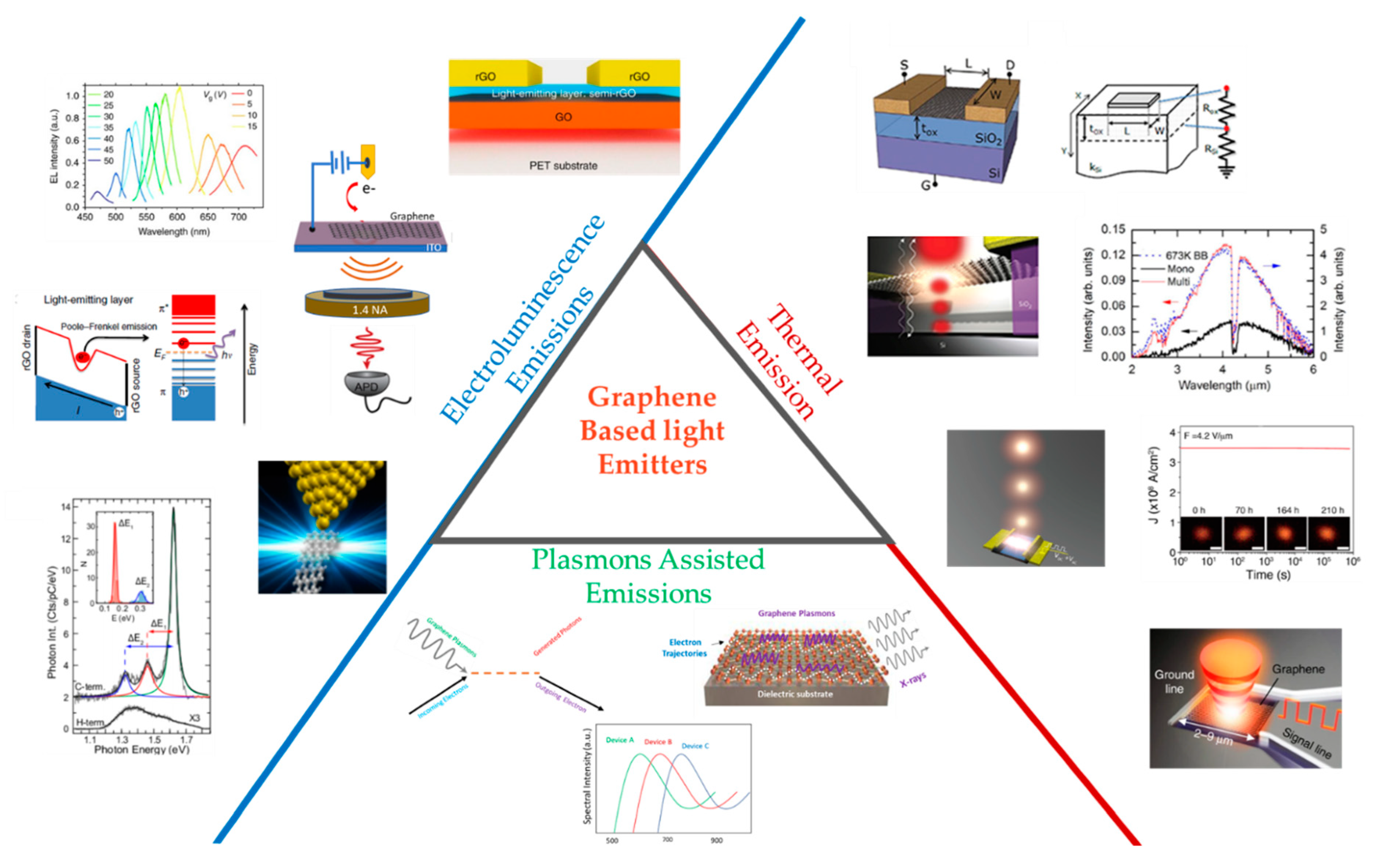
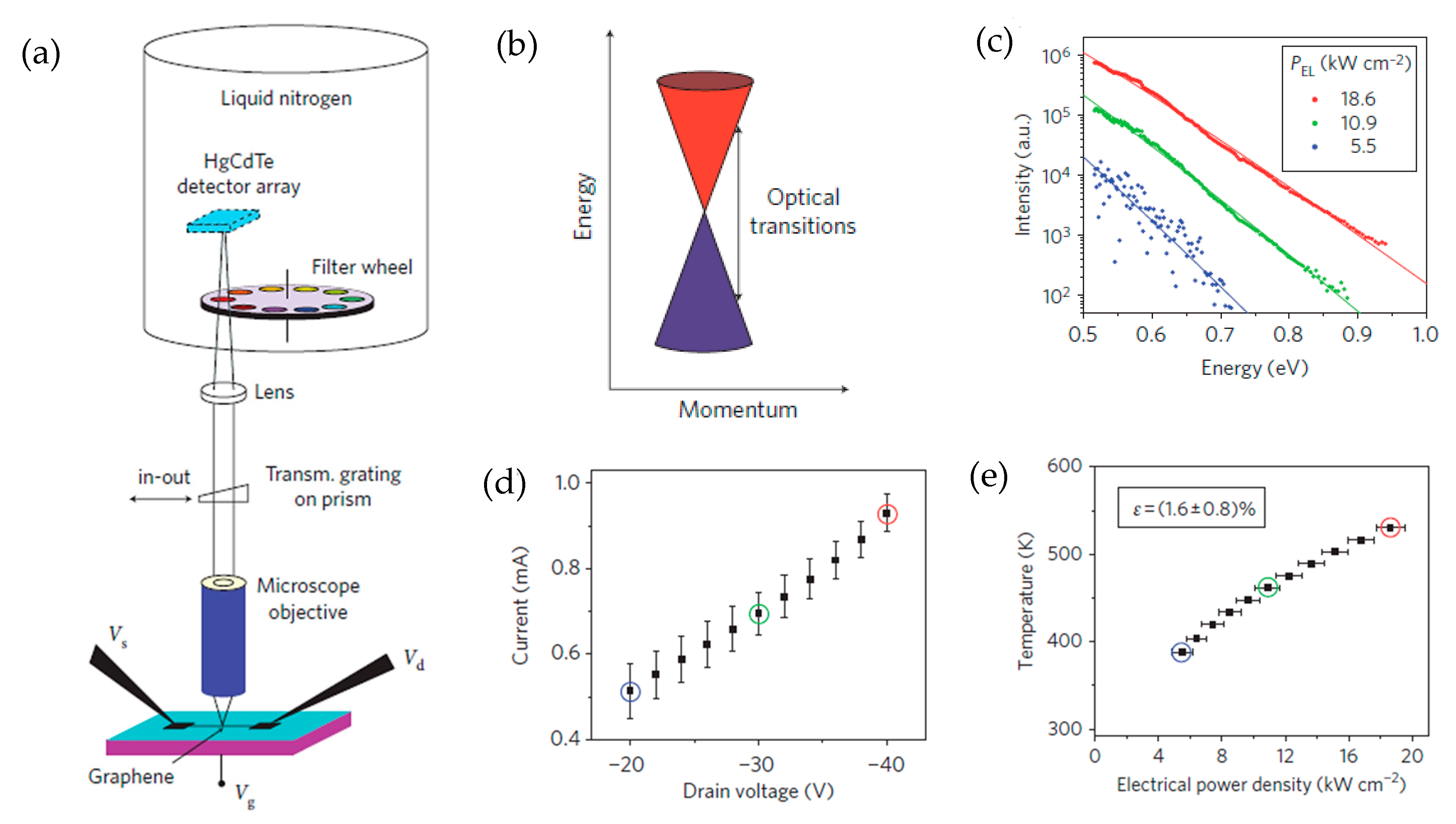


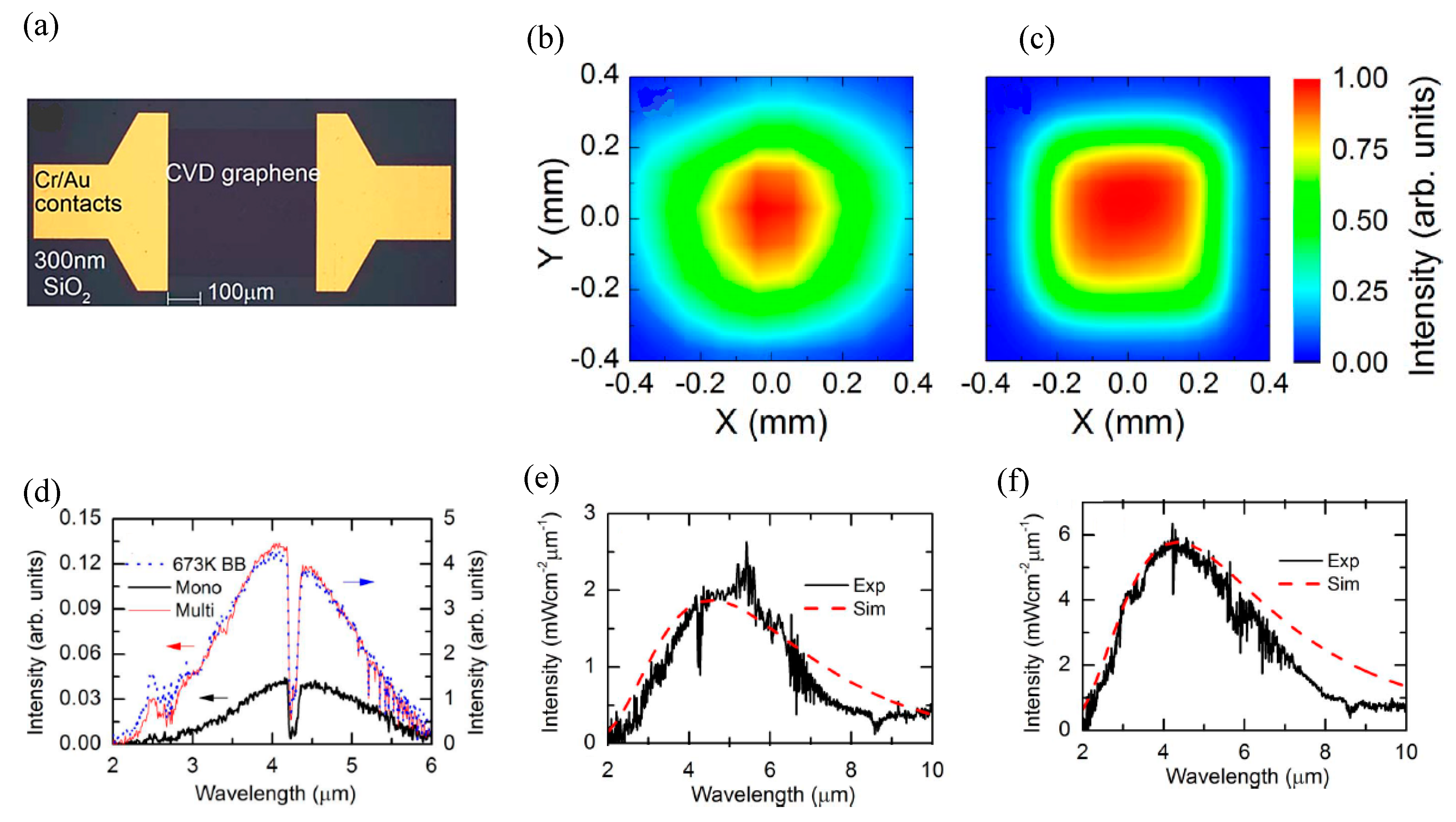
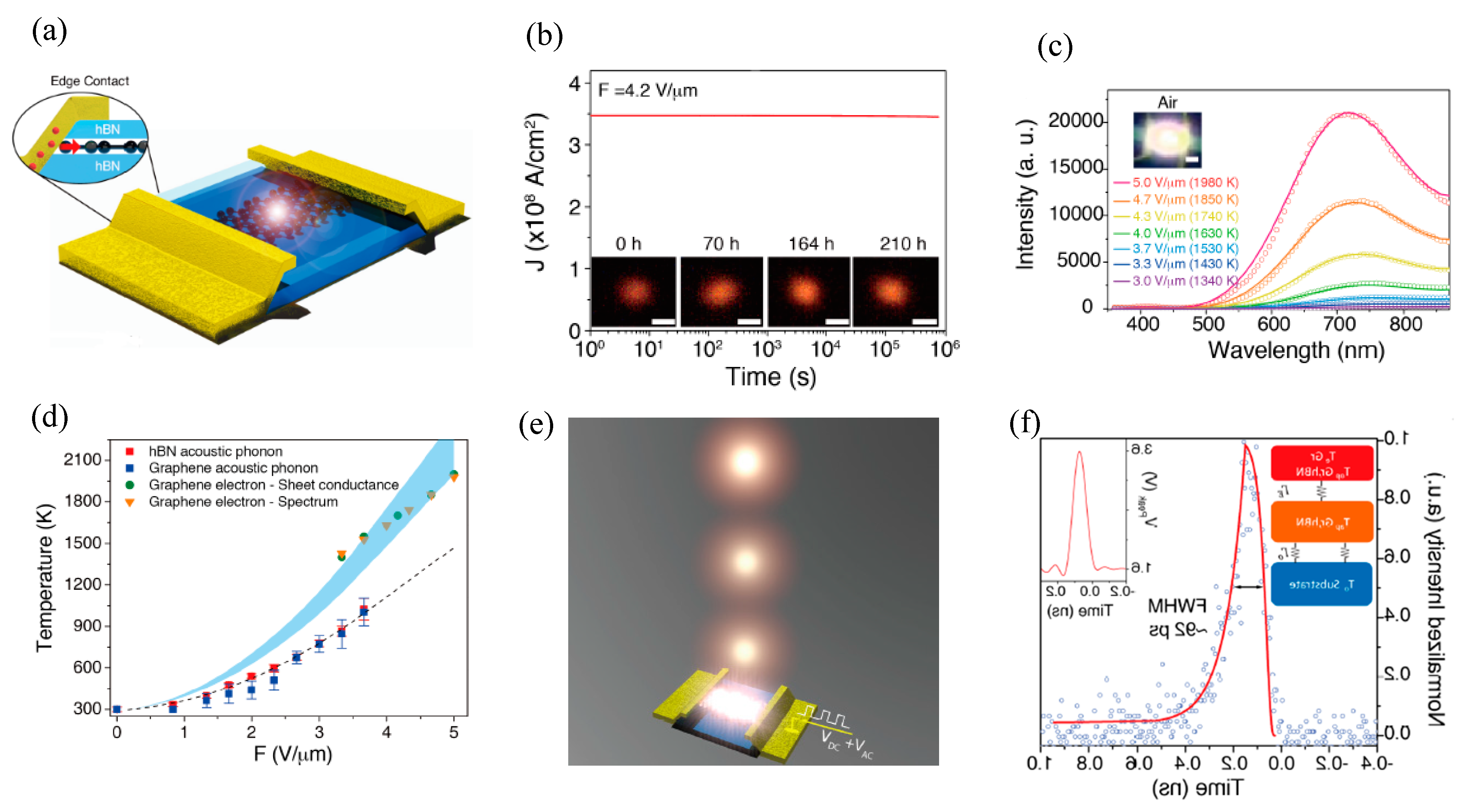
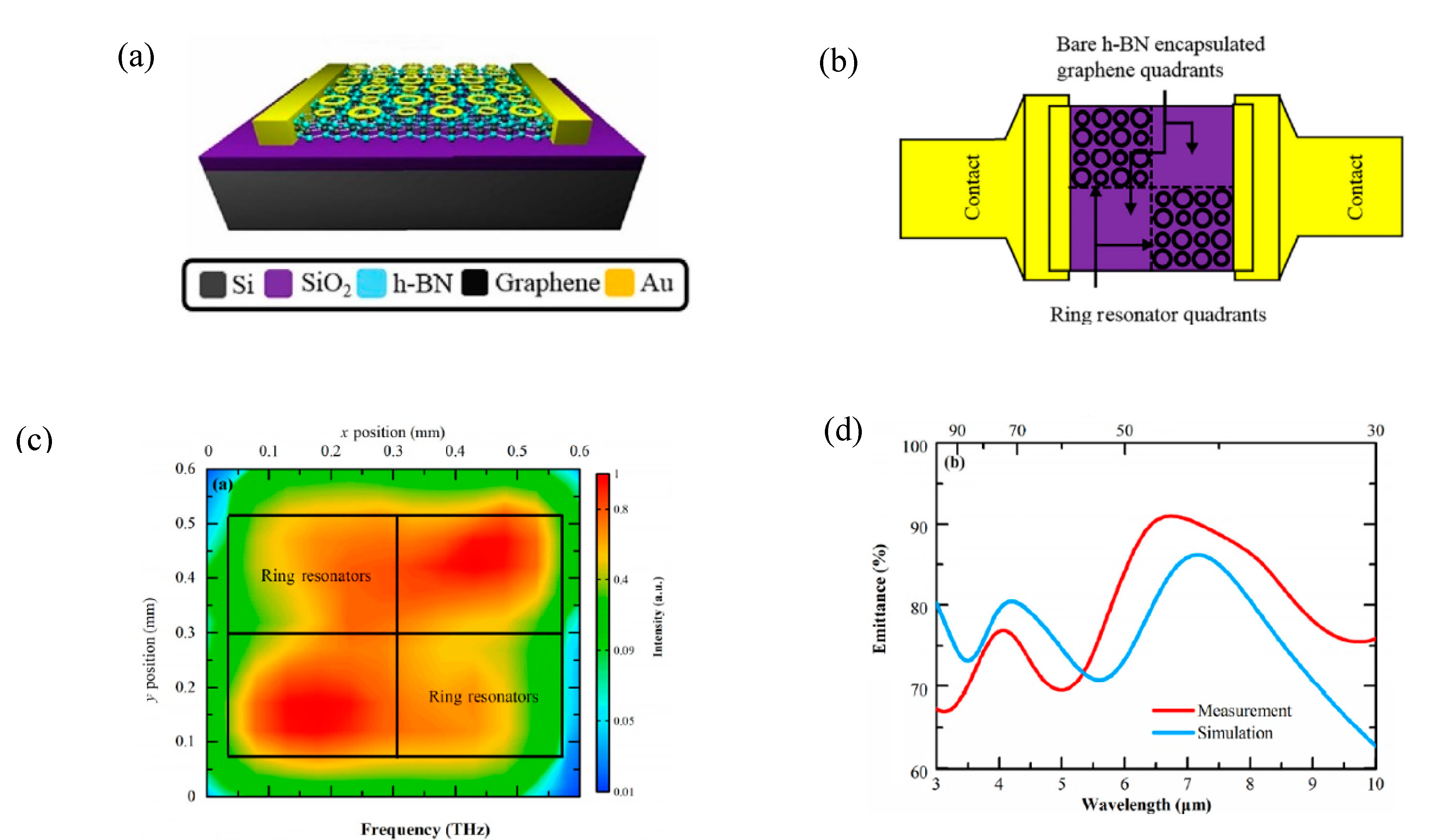
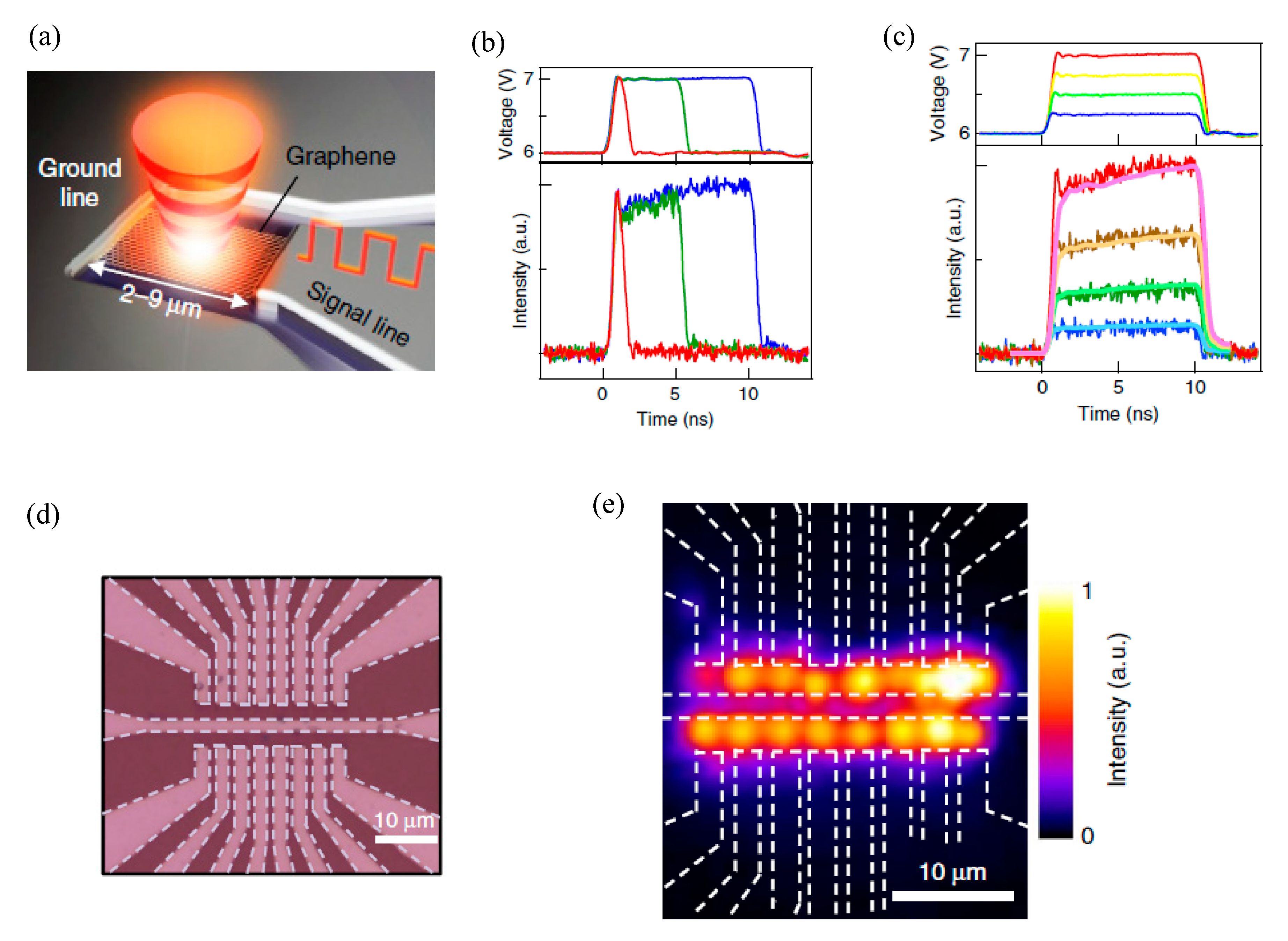
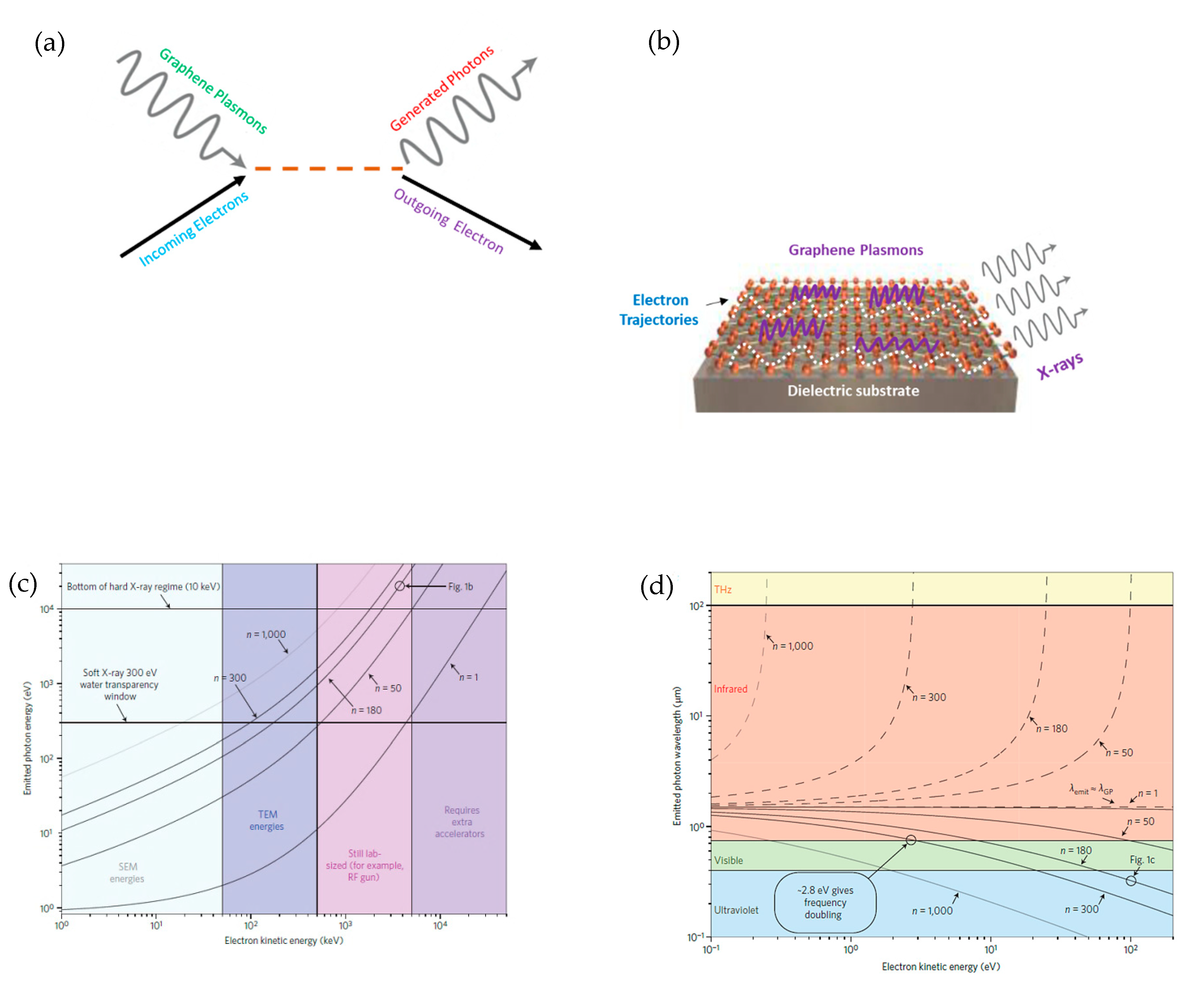
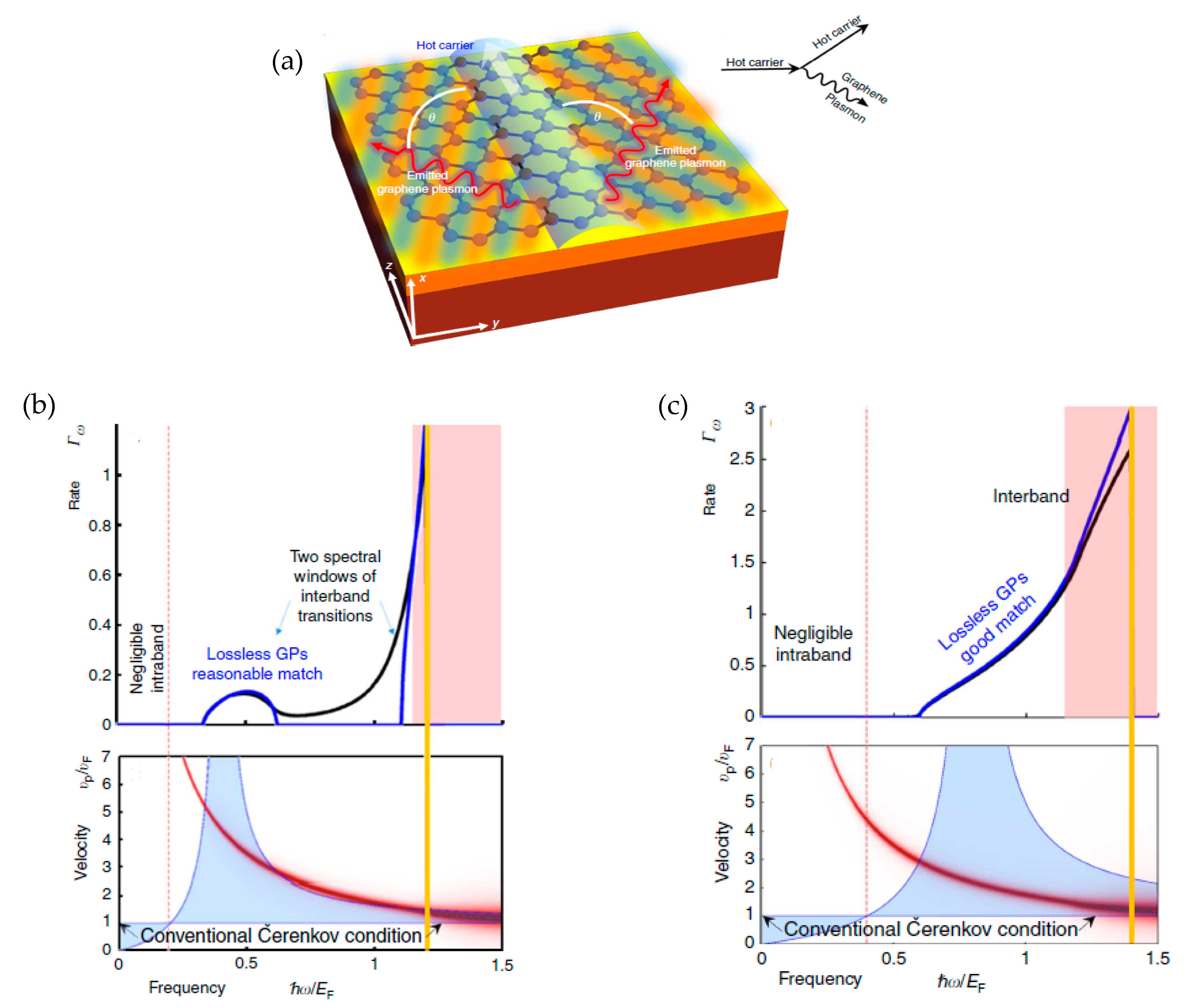
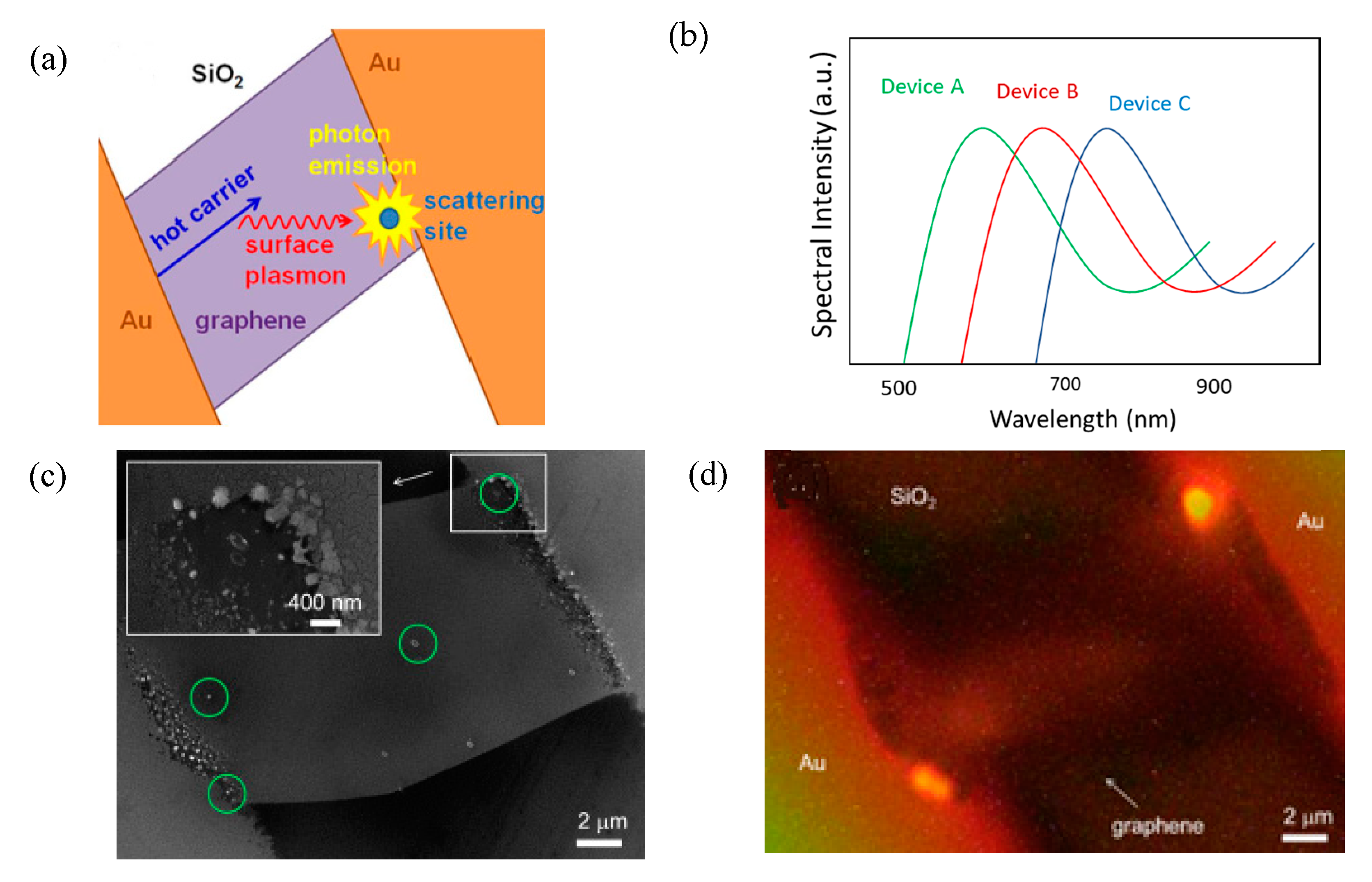
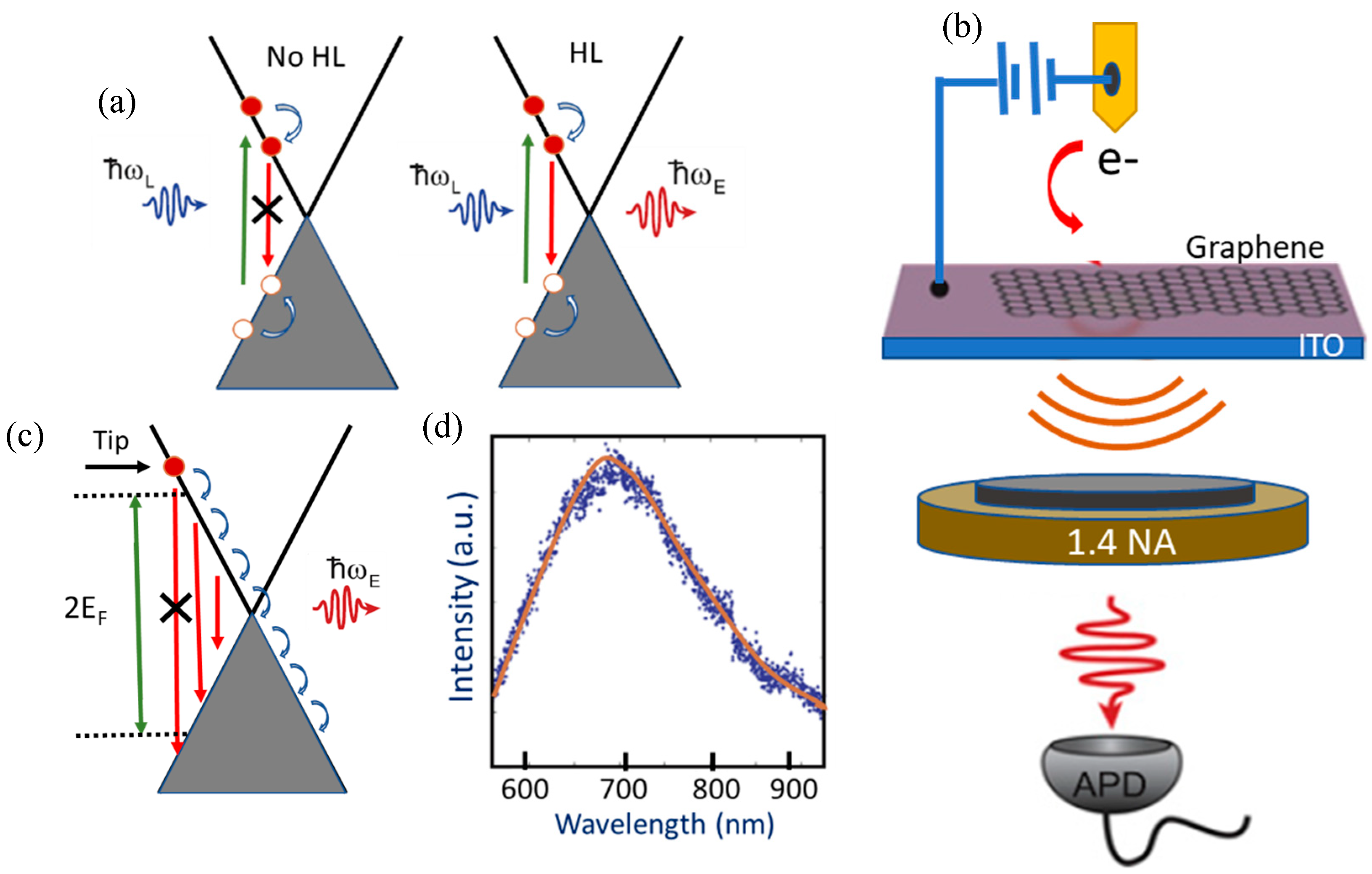
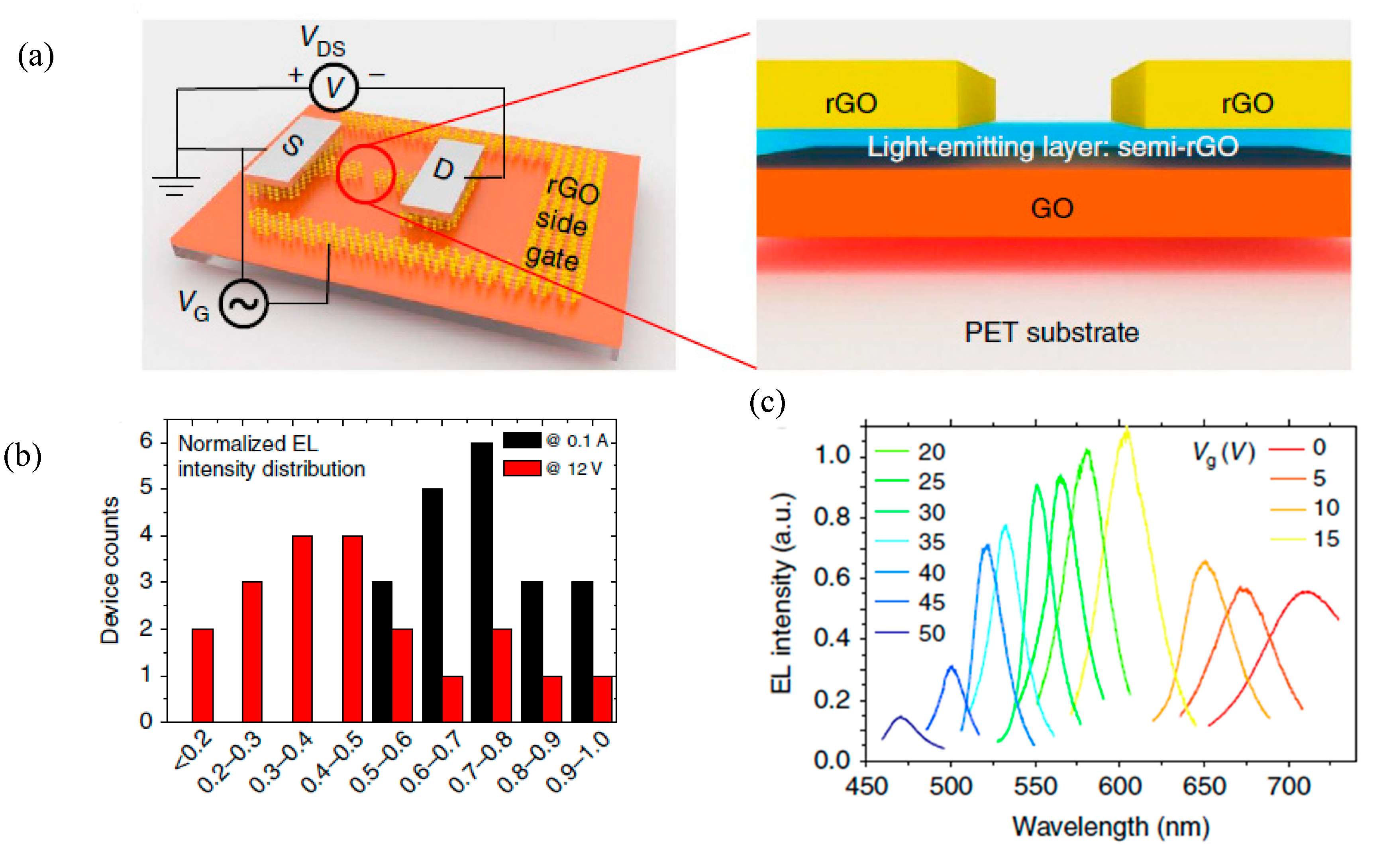

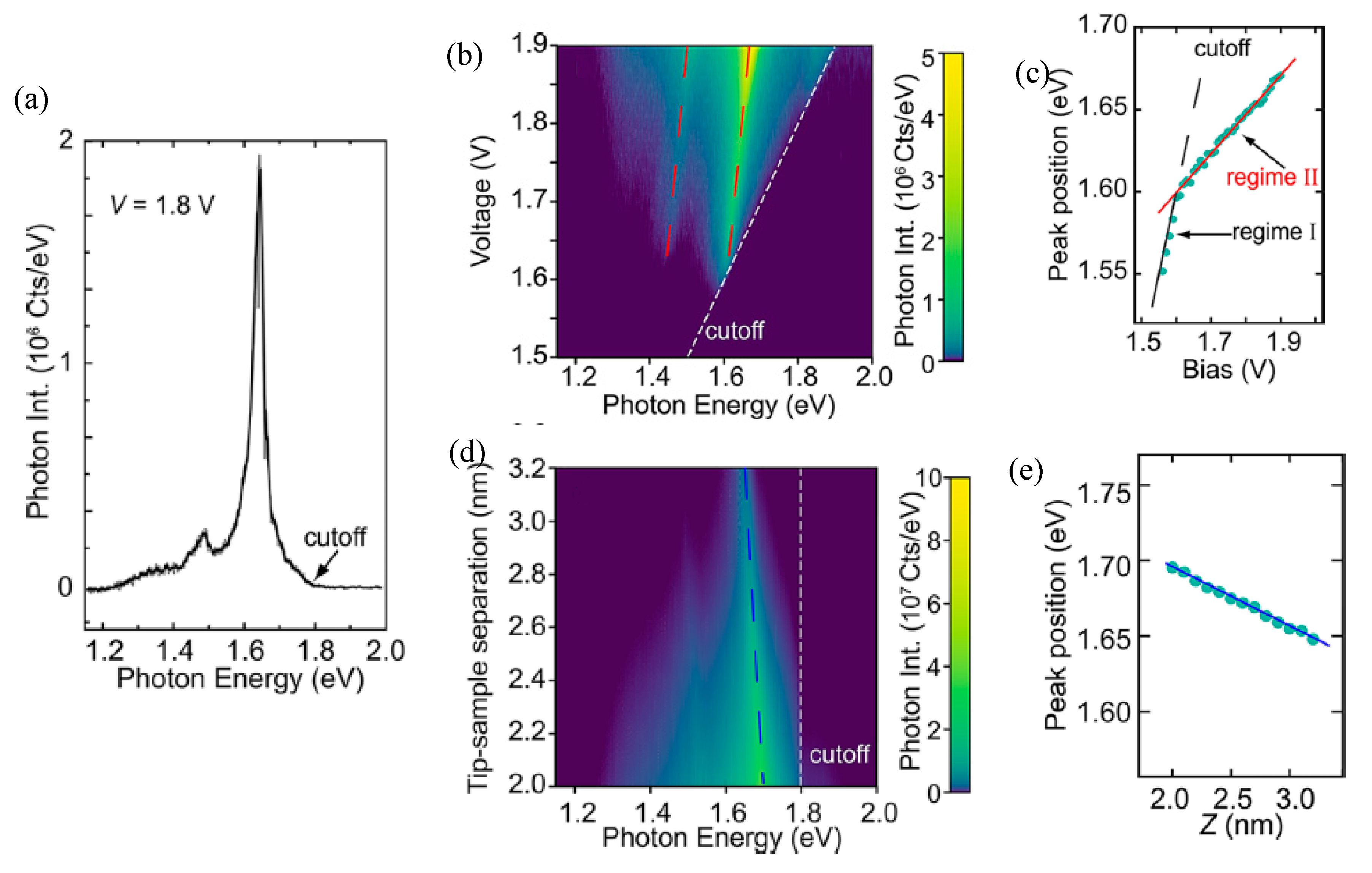
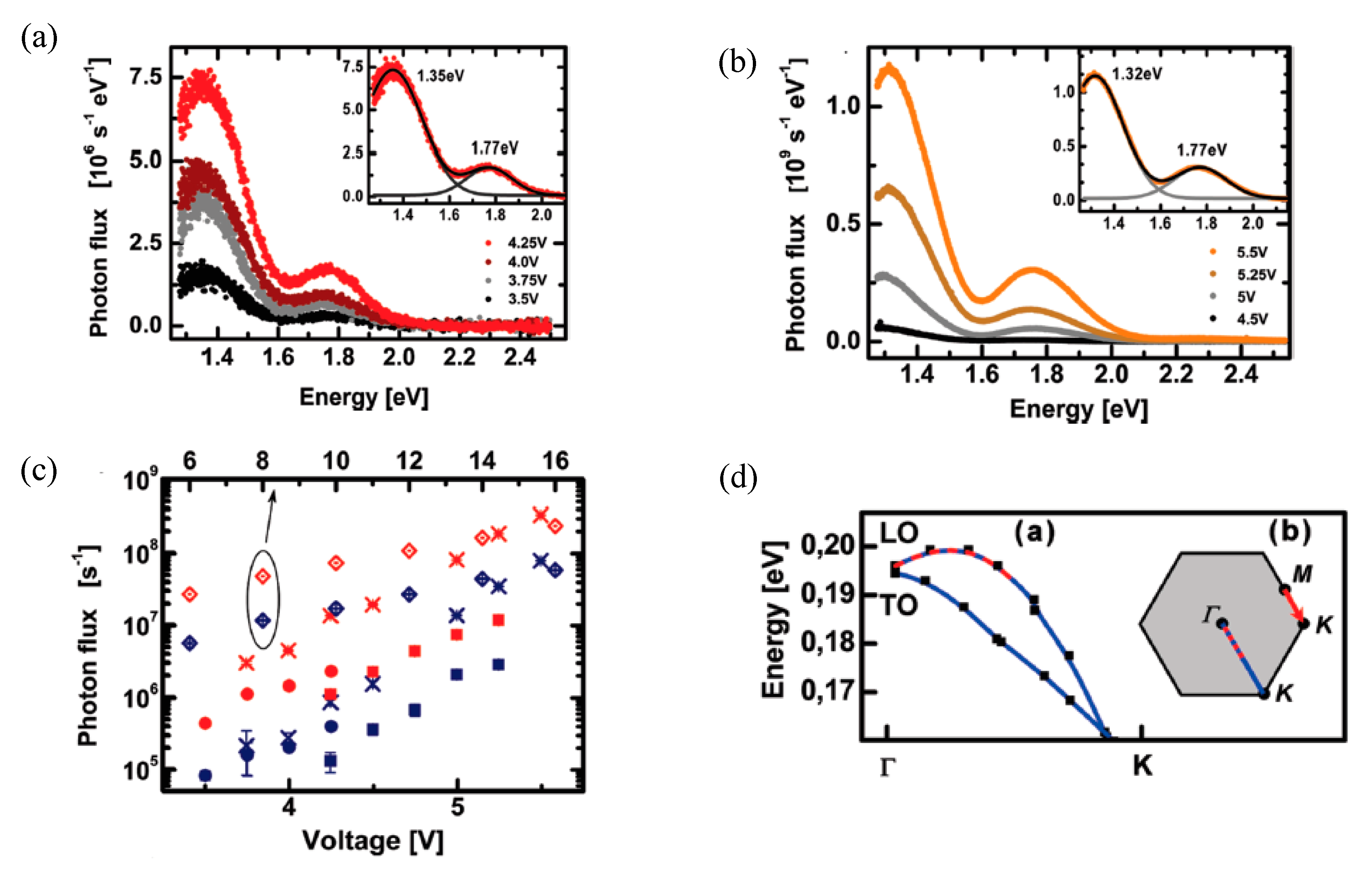
| Active Material | Deposition Method | Contact/Pattern Material | Patterning Method | Emission Mechanism | Substrate | Emission Spectrum | Authors and Reference |
|---|---|---|---|---|---|---|---|
| Graphene flakes | Mechanically exfoliation | Titanium/Palladium/Au lithographically | E-beam lithography and oxygen plasma etching | Joule heating effect | SiO2/Si | Infrared | Freitag et al. [45] |
| Graphene flakes | Mechanically exfoliation and CVD | Cr/Au electrodes Using microcontact transfer method for mechanically exfoliated graphene | E-beam lithography | Thermal radiation | Trench on SiO2/Si | Infrared to visible | Kim et al. [32] |
| Graphene | CVD Graphene | Cr/Au contact using thermal evaporation | E-beam lithography | Thermal emission | SiO2/Si | mid-infrared | Lawton et al. [46] |
| hBN/Graphene/hBN | Heterostructure (Van der Waals dry pickup method, using exfoliated Graphene flakes and hBN flakes) | Cr/Pd/Au, metal deposition | -- | Thermal emission | SiO2/Si | Visible to near-infrared (400–1600 nm) | Kim et al. [96] |
| hBN encapsulated graphene layer | Mechanically exfoliation | Au contact | -- | Thermal emission | SiO2/Si | mid-infra-red | Cheng et al. [104] |
| Graphene | Mechanically exfoliation and CVD) encapsulated with Al2O3 | Ti/Pd | E-beam lithography | Thermal emission | SiO2/Si | Near-infrared | Miyoshi et al. [62] |
| Active Material | Deposition Method | Contact/Pattern Material | Patterning Method | Emission Mechanism | Substrate | Emission Spectrum | Reference |
|---|---|---|---|---|---|---|---|
| Graphene sheet | Theoretical model | Electron-plasmons interaction | Dielectric | Soft and hard X-ray radiation | Liang et al. [116] | ||
| Graphene | Theoretical model | Quantum Čerenkov effect | - | terahertz to near-infrared | Ido Kaminer et al. [55] | ||
| Graphene | Mechanical exfoliation | Au physical vapor deposition | Wire-based shadow masking | Quantum Čerenkov effect | SiO2/Si | visible and near-infrared | A. Beltaos el al. [76] |
| Active Material | Deposition Method | Contact Pattern Material | Patterning Method | Emission Mechanism | Substrate | Emission Spectrum | Authors and Reference |
|---|---|---|---|---|---|---|---|
| Graphene | Mechanical Exfoliation | STM Analysis, using Au Tips | Hot EL | Glass Coated with ITO | ~550 To 900 nm | Beam et al. [58]. | |
| Semi Reduced Graphene Oxide | Drop Casting | Light Scribe | Poole Frankel’s Emission | PET | ~450 To 750 nm | Wang et al. [63] | |
| GNRs | Synthesized On Au Surface | STM Analysis, Using Au Tips | EL | Au (111) | Narrow Band, Red Light Emission | Chong et al. [140] | |
| FLG, SWNT, and MWNT | Dielectrophoretic Deposition | Pd, Au/Cr | E Beam Lithography | Phonon Assisted EL | Si/SiO2 | Visible Spectrum 1.4 And 1.8 eV Peaks | Essig et al. [57] |
© 2020 by the authors. Licensee MDPI, Basel, Switzerland. This article is an open access article distributed under the terms and conditions of the Creative Commons Attribution (CC BY) license (http://creativecommons.org/licenses/by/4.0/).
Share and Cite
Junaid, M.; Md Khir, M.H.; Witjaksono, G.; Ullah, Z.; Tansu, N.; Saheed, M.S.M.; Kumar, P.; Hing Wah, L.; Magsi, S.A.; Siddiqui, M.A. A Review on Graphene-Based Light Emitting Functional Devices. Molecules 2020, 25, 4217. https://doi.org/10.3390/molecules25184217
Junaid M, Md Khir MH, Witjaksono G, Ullah Z, Tansu N, Saheed MSM, Kumar P, Hing Wah L, Magsi SA, Siddiqui MA. A Review on Graphene-Based Light Emitting Functional Devices. Molecules. 2020; 25(18):4217. https://doi.org/10.3390/molecules25184217
Chicago/Turabian StyleJunaid, Muhammad, M. H. Md Khir, Gunawan Witjaksono, Zaka Ullah, Nelson Tansu, Mohamed Shuaib Mohamed Saheed, Pradeep Kumar, Lee Hing Wah, Saeed Ahmed Magsi, and Muhammad Aadil Siddiqui. 2020. "A Review on Graphene-Based Light Emitting Functional Devices" Molecules 25, no. 18: 4217. https://doi.org/10.3390/molecules25184217
APA StyleJunaid, M., Md Khir, M. H., Witjaksono, G., Ullah, Z., Tansu, N., Saheed, M. S. M., Kumar, P., Hing Wah, L., Magsi, S. A., & Siddiqui, M. A. (2020). A Review on Graphene-Based Light Emitting Functional Devices. Molecules, 25(18), 4217. https://doi.org/10.3390/molecules25184217










